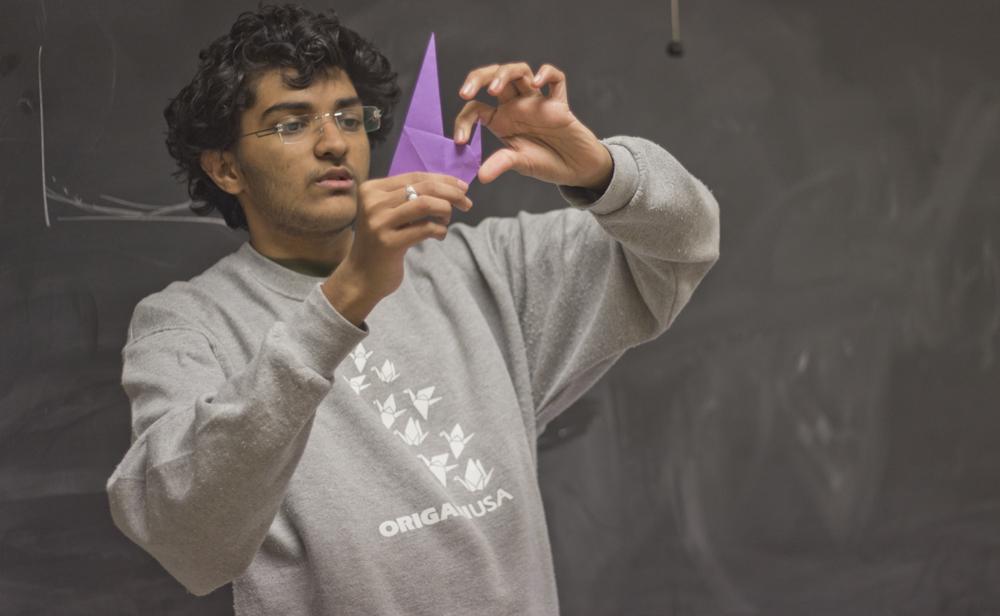Bruin Origami Society co-founders teach UCLA students art

Harsh Karthik, a second-year applied mathematics student, showed members of the Bruin Origami Society how to create origami art at one of the club’s Monday night meetings.
By Chloe Lew
Nov. 20, 2013 1:04 a.m.
The slow, stretched jazz notes of Miles Davis’ “Blue in Green” harmonized with the rhythm of focused fingers smoothing little, bright blue squares of paper.
The last of the students settled into their desks, ready to get to work on their origami – the chalkboard was already covered in a disarray of diagrams.
In a basement classroom in Haines Hall, half a dozen UCLA students in the Bruin Origami Society gathered on the evening of Nov. 4 to fold paper seals and musical notes.
Roommates Harsh Karthik, a second-year applied mathematics student, and James Han, a second-year English student, co-founded the club for origami enthusiasts in spring 2013.
During weekly Monday meetings, Karthik and Han teach five to 10 club members beginner and advanced origami models from memory while listening to jazz music.
Karthik and Han discovered their mutual interest in origami during their freshman year as roommates, when Karthik noticed an origami book on Han’s desk. Two quarters later, Karthik approached Han with the idea of starting a club specifically dedicated to the craft.
“We’re both really interested in origami as a hobby and an art,” Karthik said. “We just thought, ‘We can’t be the only two people in the whole university.’”
Han said the only way to find fellow origami enthusiasts was to create a place where they could meet – so he did.
Han entered the classroom before the club’s meeting and immediately began setting up, sliding out his laptop and a small box designed in the image of a Hollywood clapperboard. He reached into the black-and-white box and pulled out a spectrum of vibrantly colored sheets of paper.
While Karthik distributed the bold blue sheets that were to be folded into musical notes, Han selected a warm brown for the seals.
Since its establishment, Bruin Origami Society has been invited to several campus events, including Bruins Fighting Pediatric Cancer’s Cranes for Cancer event last spring and Night Powell’s Stressbusters Origami Table during finals week last spring.
Some club members said the appeal of origami lies in its relaxing effect.
“There’s a certain feeling of Zen when you’re doing it for a long time,” said Vlad Vysotsky, a first-year computer science student and member of the club. Vysotsky was the one who suggested the club listen to jazz music during meetings.
Karthik, easily distracted by turns in the conversation, moved sporadically about the room. One moment, he was holding his own blue sheet up high and explaining the next fold. The next, he was pulling other origami samples up on his laptop and illustrating his ideas through frenzied chalkboard drawings.
Karthik said he was introduced to origami when he was 7 years old, but did not approach it as an art until he was 14.
“Until then, it was some sort of a passive hobby,” Karthik said. “There’s a lot to do with origami, though. I wanted to start challenging myself.”
Han said he picked up origami during childhood as well, through folding fortune tellers in elementary school. Soon after his first experience, Han checked out origami books at the library, which became a launchpad for his own origami experimentation.
Han grew up in an isolated area in Michigan and would spend several hours each day doing origami, he said.
Still walking about the front of the room, Karthik told members that creating an origami base for the musical notes requires dozens of patient folds. He described the process as an oscillation between pleats – a technique in origami dubbed “pleat-sinking.”
Han and Karthik have designed models such as dragons and Rorschach masks from the graphic novel Watchmen by starting with a general origami base and then experimenting with details later.
The designs and creases are aesthetically pleasing to Karthik, who said he likes the geometric side of origami.
“(Origami) is all made from a piece of paper – no cuts, no glue. I’m very much like an origami purist. I cannot take people who cut or glue seriously,” Han said, laughing.
Sharing his favorite origami model, Vysotsky said he sometimes uses lock-picking tools to aid his folding with particularly minuscule paper cranes. His paper cranes are about one-third the size of a penny, Vysotsky said while shaping a tiny circle with his index finger and thumb in demonstration.
Other members entered the club as beginners.
Before the club, first-year chemistry student Jong Choi said he could only make paper airplanes, but Karthik and Han have been accommodating in hosting separate sessions for beginner students.
“I have no creativity,” Choi said with a laugh. “The fact that I can make a certain figure with just one paper makes me feel like I have some sort of power in making something.”
Karthik and Han said they hope to host a paper plane design competition in the future. In preparation for next November’s Origami Day, the co-founders hope to fold 1,000 paper cranes and send them to a memorial in Japan.
As Vysotsky smoothed out the final crease of his musical notes, Karthik walked over to inspect.
Few words were exchanged. Beaming, Karthik extended a hand of respect, and Karthik and Vysotsky shook on a job well done.


